- Overview
- Step 1: Install MySQL, PHP and Apache
- Step 2: Configuring PHP Settings
- Step 3: Download & Extract ProcessMaker
- Step 4: MySQL Configuration
- Step 5: Configure Apache
- VirtualHost in Apache 2.2
- VirtualHost in Apache 2.4
- Enable Apache modules
- Apache Configuration Issues
- Step 6: Setting up ProcessMaker
- Step 7: Additional Configuration
- Errors during Installation
Overview
| Note: Take into notice that this platform is not officially supported by ProcessMaker. The OpenSUSE installation has been included under the experimental section, since this installation has NOT being tested by ProcessMaker QA department. |
Follow these instructions to install ProcessMaker 3.0 or later on top of a LAMP (Linux, Apache, MySQL, PHP) stack in OpenSUSE.
| ProcessMaker Version | Platform | Notes |
|---|---|---|
| ProcessMaker 3.0 - 3.0.1.6 | OpenSUSE 11.2 - 13.1 OpenSUSE Leap 42.1 |
|
| ProcessMaker 3.0.1.7 - 3.0.4 | OpenSUSE 13.1 OpenSUSE Leap 42.1 |
PHP needs to be upgraded to version 5.5.33 or higher (5.6 is recommended). |
Before installing ProcessMaker, check the Installation Requirements to see whether your server meets the necessary hardware and software requirements.
Step 1: Install MySQL, PHP and Apache
| Warning: ProcessMaker is not compatible with MySQL STRICT mode, which is enabled by default as of MySQL 5.6.6. Read the Turning Off MySQL STRICT Mode section to learn how to disable it. |
If the LAMP stack isn't already installed, open a terminal by going to Applications > Accessories > Terminal.
At the command line, login with administrative powers (or as root if its password was set):
Then, follow the instructions according to your OpenSUSE version:
In OpenSUSE 11.2:
Install Apache, MySQL and PHP and all their necessary modules:
Set MySQL to automatically start as a service at bootup and turn on the service:
Then, set Apache to automatically start as a service at bootup and turn on the service:
Make sure that the apache2 and mysql services will start on bootup. They should be listed as "on" for the runlevel on which your installation of OpenSuSE runs, which is generally level 5:
Check that Apache and PHP are working correctly, by adding an index.php file:
Put this code in the file and save it:
Then, open a web browser on the server and enter the address:
http://localhost
Information about PHP should appear in the browser window, indicating that PHP is working correctly:
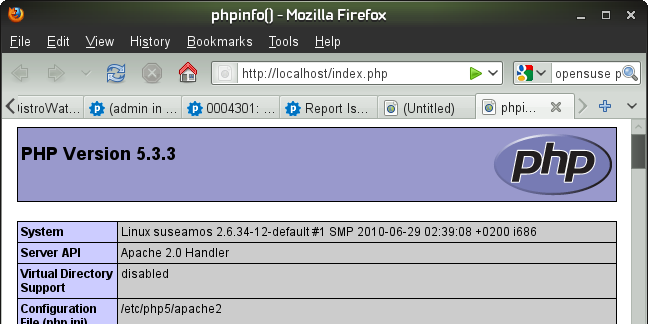
In OpenSUSE 13.1:
Install Apache, MySQL and PHP and all their necessary modules:
OpenSUSE 13.1 has MariaDB installed by default. The above command will uninstall MariaDB and replace it with MySQL.
Warning: MariaDB is not a supported database. MySQL is the default database system for ProcessMaker. To avoid issues with MySQL, ensure MariaDB is not installed.
Set MySQL to automatically start as a service at bootup and turn on the service:
Then, set Apache to automatically start as a service at bootup and turn on the service:
In OpenSUSE Leap 42.1:
Take into consideration that ProcessMaker 3.0.1.8 and ProcessMaker 3.0.2 requires PHP 5.5.33 or higher. The standard repositories for OpenSUSE Leap 42.1 distribute only PHP 5.5.14. Therefore, it is necessary to add the repository of openSUSE 13.2 to download a higher version of PHP (PHP 5.6.9).
Add the OpenSUSE 13.2 repository:

Install Apache, PHP and all their necessary modules with the following command:
Set Apache to automatically start as a service at bootup and turn on the service:
OpenSUSE 42.1 has MariaDB 10.1 installed by default. The following command will uninstall MariaDB, and it will replace it with MySQL Community Server 5.6.30.
Type "y" to install MySQL.

Warning: MariaDB is not a supported database. MySQL is the default database system for ProcessMaker. To avoid issues with MySQL, ensure MariaDB is not installed.
Then, set MySQL to automatically start as a service at bootup and turn on the service:
Install PhpMyAdmin
In addition, phpMyAdmin can be installed to easily view the MySQL databases used by ProcessMaker inside a web browser.

Step 2: Configuring PHP Settings
First, enable the php5 module for Apache.
Then, restart the Apache service:
OpenSUSE 11.2:
After that, open the PHP's configuration file php.ini located at /etc/php5/apache2/php.ini with your favorite editor.

Search for the following lines and edit them using the following configurations:
Step 3: Download & Extract ProcessMaker
Go to ProcessMaker's SourceForge page and download a recent tarball of ProcessMaker, which should be named processmaker-X.X.X.X-community.tar.gz.
After the download has finished, decompress the tarball in the directory where ProcessMaker will be installed. ProcessMaker can be installed in any directory which is not publicly accessible to the internet (so do NOT install it in /var/www), but it is generally installed in /opt, since it is an optional program which doesn't come from the standard repositories:
Verify that ProcessMaker was correctly decompressed:
The processmaker directory should contain the following contents:

Set file permissions
Then, issue the following commands as the "root" user so that ProcessMaker can access the necessary files when run by the Apache server:
After these changes, verify the permissions and owner of the processmaker directory with the command ls -l.

Step 4: MySQL Configuration
| Warning: ProcessMaker is not compatible with MySQL STRICT mode, which is enabled by default as of MySQL 5.6.6. Read the Turning Off MySQL STRICT Mode section to learn how to disable it. |
Set up a secure installation of MySQL, by setting a root password and removing the "test" database:
Follow the wizard to secure MySQL:

Here it is necessary to enter root password:

In the next part, it is possible to change the root password if wanted.

Then, remove anonymous users by choosing "Y":

In this part, the prompt will ask about disabling root login. Answer Y to disable remote access.

Then, it is possible to remove the default "Test" database:

Finally, reload privileges tables:

Once done, restart the "mysql" service.
OpenSUSE 11.2:
MySQL Configuration Issues
Setting the root Password
If MySQL doesn't have a root password, set one for better security:
If you have forgotten the root password, see these instructions to reset it.
Starting as a Service
When logging into MySQL, if the following error message appears:
Then, MySQL needs to be started as a service:
Step 5: Configure Apache
Copy the sample ProcessMaker configuration file (which is named pmos.conf.example in version 3 and virtualhost.conf.example in version 2.8) to Apache's conf.d directory:
Then edit the pmos.conf file to fit your environment:
The Apache configuration to run ProcessMaker depends on the version of Apache installed.
VirtualHost in Apache 2.2
If using Apache 2.2, then use the following VirtualHost configuration. In the pmos.conf file, replace your_ip_address and your_processmaker_domain with the IP address and domain name used by your ProcessMaker server:
Replace your_ip_address with the IP number or domain name of the server running ProcessMaker. If only planning on running and accessing ProcessMaker on your local machine, then use the IP address "127.0.0.1". If using ProcessMaker on a machine whose IP address might change (such as a machine whose IP address is assigned with DHCP), then use "*", which represents any IP address. If not using the standard port 80, then it is necessary to also specify the port number.
If your DNS or /etc/hosts has a defined domain for ProcessMaker, then use that domain for your_processmaker_domain. Otherwise, use the same IP address for your_processmaker_domain as was used for your_ip_address. For more information, see the Apache Virtual Hosts Documentation.
Note: It is also possible to define the virtual host for ProcessMaker directly in the Apache configuration by inserting the above VirtualHost definition in the /etc/apache2/apache2.conf file.
Example 1:
ProcessMaker is installed in the /opt/processmaker directory and is running on a server at the address 192.168.1.100:
Example 2:
ProcessMaker is installed in the /user/fred directory on your local machine at port 8080 with an dynamic IP assigned by DHCP:
Example 3:
ProcessMaker is installed in the /opt/pm3.0.1.7 directory at the IP address 123.45.67.89 and the domains www.example.com and any variant of X.example.com:
Note that www.example.com and *.example.com need to be defined in the server's DNS or /etc/hosts file for this example to work correctly.
VirtualHost in Apache 2.4
If using Apache 2.4, then use the following VirtualHost configuration. In the pmos.conf file, replace your_ip_address, your_processmaker_domain with the IP address or domain name used by your ProcessMaker server, and replace the line "Allow from all" for Require all granted.
Replace your_ip_address with the IP number or domain name of the server running ProcessMaker. If only planning on running and accessing ProcessMaker on your local machine, then use the IP address "127.0.0.1". If using ProcessMaker on a machine whose IP address might change (such as a machine whose IP address is assigned with DHCP), then use *, which represents any IP address. If not using the standard port 80, then it is necessary to also specify the port number.
If your DNS or /etc/hosts has a defined domain for ProcessMaker, then use that domain for your_processmaker_domain. Otherwise, use the same IP address for your_processmaker_domain as was used for your_ip_address. For more information, see the Apache Virtual Hosts Documentation.
Note: It is also possible to define the virtual host for ProcessMaker directly in the Apache configuration by inserting the above VirtualHost definition in the /etc/apache2/apache2.conf file.
Example 1:
ProcessMaker is installed in the /opt/processmaker directory and is running on a server at the address 192.168.1.100:
Example 2:
ProcessMaker is installed in the /user/fred directory on your local machine at port 8080 with an dynamic IP assigned by DHCP:
Example 3:
ProcessMaker is installed in the /opt/pm3.0.1.7 directory at the IP address 123.45.67.89 and the domains www.example.com and any variant of X.example.com:
Note that www.example.com and *.example.com need to be defined in the server's DNS or /etc/hosts file for this example to work correctly.
Enable Apache modules
ProcessMaker needs to use the following modules in the Apache 2 web server:
- expires
- rewrite
- deflate
- vhost_alias
All these modules are included in openSUSE's apache2 package, but usually only expires is enabled by default. Therefore, enable then with one of the following ways:
From Graphical Interface (YaST2)
To enable the other Apache modules from the graphical interface, open the YaST2 Control Center.
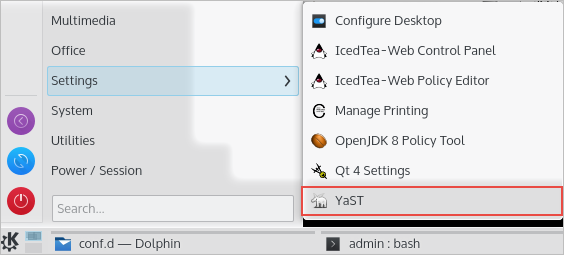
Go to System , click on /etc/sysconfig Editor and a new dialog window will open.
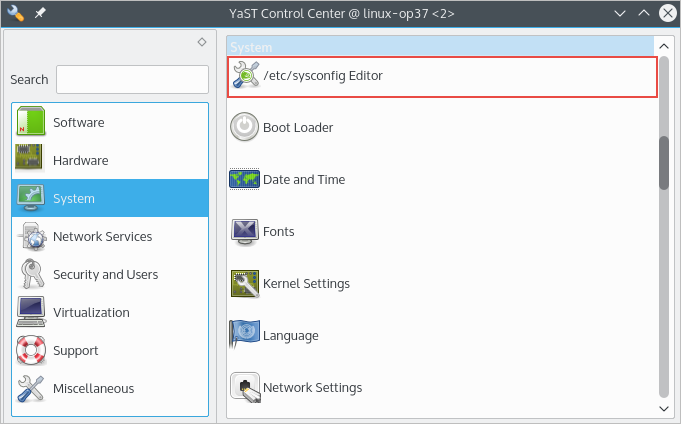
In the dialog, go to Network > WWW > Apache2 > APACHE_MODULES.
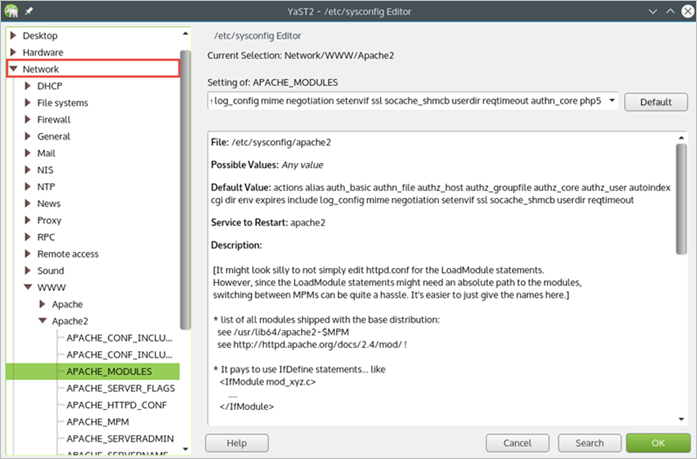
Make sure that expires is in the list of modules.

After that, add the following at the end of the APACHE_MODULES line:

Note: If using Apache 2.4 (which is found in OpenSUSE 13.1 and later), also include the module filter in the list of APACHE_MODULES.
YaST2 will display the following dialog to save the variables. Click on "Save" to confirm.
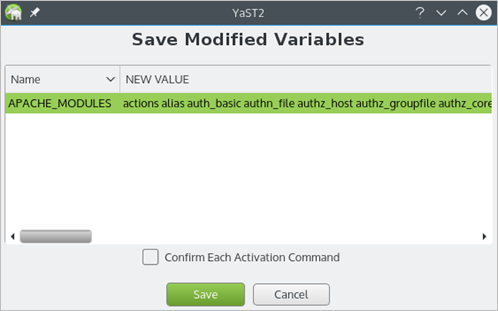
From Command Line
To enable the Apache modules from the command line, run the following command:
Search for the APACHE_MODULES variable and edit its list of modules to include expires, rewrite, deflate and vhost_alias.
Note: If using Apache 2.4 (which is found in OpenSUSE 13.1 and later), also include the module filter in the list of APACHE_MODULES.

Once done, save changes and close the file.
After adding pmos.conf and enabling modules, it is necessary to restart the Apache web server:
OpenSUSE 11.2:
Apache Configuration Issues
Service not starting
If the Apache service does not start.

Enter the following command to see whether there are any problems in the Apache configuration
In OpenSUSE 13.1 and later:
Non-standard Port
If running ProcessMaker off a port other than the default port 80, then add the following line to the file /etc/apache2/listen.conf:
For instance, if running ProcessMaker from the local machine at port 8080:
Or simply:
Note: If Apache is using the default port 80, then configure other programs (like Skype) to not use port 80. Check whether a program is currently listening on port 80 with the command:
No VirtualHosts Warning
If you see one of the following messages when reloading or restarting Apache:
Then, comment out or delete the following lines in the file /etc/apache2/listen.conf:
Server's Domain Name Warning
If the following warning message appears when restarting Apache:
To avoid this message, edit the /etc/apache2/apache2.conf file and add the following line:
For example, if installing ProcessMaker on a server located at the IP address 192.168.0.100:
If installing ProcessMaker for local use on the same computer:
Step 6: Setting up ProcessMaker
Open a web browser and enter the IP address (and port number if not using the default port 80) where ProcessMaker is installed. For instance, if ProcessMaker is installed at the address 192.168.10.100, then go to: http://192.168.10.100
If using ProcessMaker which is installed locally on port 8080, go to: http://127.0.0.1:8080
Then follow the steps in the Installation Wizard in the web browser to complete the installation of ProcessMaker.
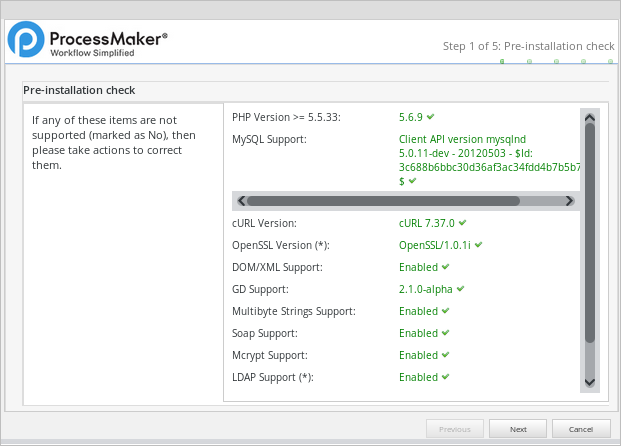
Step 7: Additional Configuration
Additional aspects of ProcessMaker may need to be configured. See Additional Server Configuration and the Administration section of the wiki. Most installations of ProcessMaker need to configure the following:
Setting the Time Zone
The default time zone for the ProcessMaker server can be set by logging into ProcessMaker with the "admin" user and going to Admin > Settings > System and setting the Time Zone. Another way to set the time zone is edit the env.ini configuration file.
Configuring Email
If planning on sending out email notifications or enabling users to recover forgotten passwords, then see Email - Settings to configure ProcessMaker to use an email server.
Execution of cron.php
If planning on using email notifications or timer events, then the server running ProcessMaker has to be configured to periodically execute the cron.php file. See Executing Cron Scripts.
Errors during Installation
If an error occurs during the installation, check the installation log file:
Depending on the errors found in the installation log file, check the following files:
The Apache configuration file:
The ProcessMaker web site configuration file for Apache:
The PHP configuration file:
The MySQL configuration file:
The ProcessMaker configuration file where components are installed:
The ProcessMaker configuration file for database connections:
The ProcessMaker redirection to login screen:
If the following error appears at the login screen:

This error indicates that the installer was unable to access the MySQL databases to install the translations. Make sure that the MySQL port (which is 3306 by default) isn't blocked by a firewall and MySQL is configured to accept connections from the server running ProcessMaker.
If having other issues, please ask for help on our ProcessMaker forum.



